
namm
(Mostly) Wordless Wednesday: NAMM Oasis
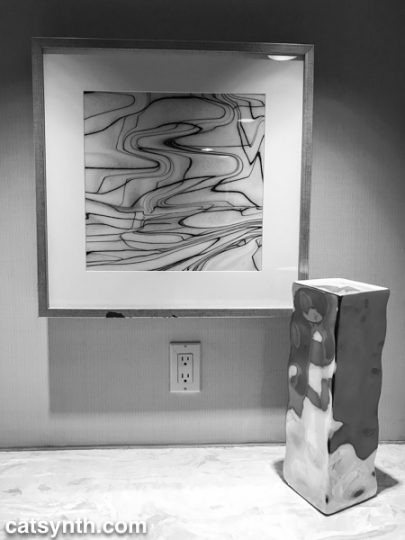
Scene featuring two art pieces in a niche at the Hilton Anaheim while running around between parties and other social gatherings on the last night of NAMM. It was a quiet and arresting tableau amidst the chaos and cacophony.
Some may be quick to deride “hotel art”, but these two pieces would look very much at home at CatSynth HQ regardless of provenance.
For more “wordless” fun, please check out our completely wordless latest video.
NAMM 2019: Arturia MicroFreak (First Look)
One of the most talked-about releases at NAMM (at least within our circles) was the new MicroFreak from Arturia. So, of course, we at CatSynth had to check it out.

It is a unique-looking instrument. The panel is etched with a variety of iconography
Beyond its looks and keyboard, the main feature of the MicroFreak is its digital oscillator. There are several different “types” for the oscillator, including wavetable, sampling, physical modeling, virtual analog, and something called “texturizer”. Within
The digital oscillator followed in the signal chain by an analog filter, specifically an Oberheim SEM-style filter, which sounds quite good when the oscillator is set to a rich source. There also the usual array of modulators, including envelope (one-shot and cycled), LFO, and arpeggiator. The sequencer includes a bunch of compositional functions with cute names like “Spice” and “Dice” to help build and modify patterns, which then can be routed via the modulation matrix.
It is quite a powerful instrument, but attempting to play it was a bit intimidating at first. Unlike the MiniBrute (analog) or even the Sequential Prophet 12 (hybrid), the knobs weren’t quite as intuitive for someone used to a lot of subtractive or semi-modular synthesizers, especially the oscillator with its various modes and the composition functions. I suspect it was an easier first-experience for those who use beat and sample boxes like those from Elektron. Indeed, I was able to get more out of it by turning on the arpeggiator and then turning knobs. You can see a bit of my initial attempts in our recent video.
In order to really understand what this little beast has to offer, a deep dive in the studio would be required. We at CatSynth hope to be able to arrange that in the not-to-distant future, and will report back here and on CatSynth TV.
NAMM 2019: New Modules from 2hp
We at CatSynth are fans of
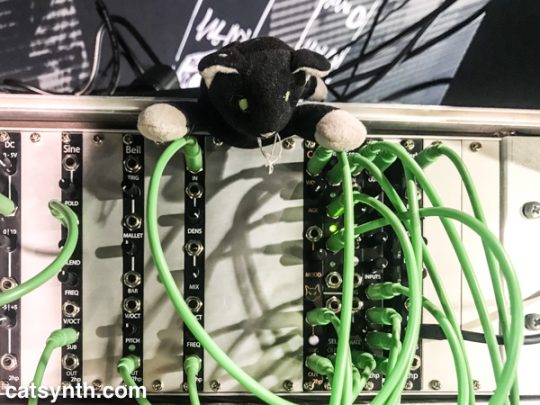
At this year’s NAMM show, the debuted four new modules covering both utilitarian and creative terrain. The one that most intrigued me was the Bell, a physical modeling voice that brings metallophone sounds. It can do vibraphone-like sounds, wine glasses, bowls, and of course, bells. With the main mallet and bar parameters (indicating that is likely based on modal synthesis), one can get a variety of combinations with CV modulation. This looks like a lot of fun – I already on the Pluck – and look forward to its release.
At the other end of the spectrum is the DC module. It offers three different DC offsets along a -5v, +5v, and 10v scale. These are useful utilities when crafting specific CV signals. I could see this pairing nicely with a Make Noise Maths for more precise control, or for tuning 1v/Oct controls.
Next up is the Sine, which is more than a simple sinewave generator. It does have a pure sine wave, but also a sub that allows blending of the fundamental, one octave below, and half an octave above. It also includes a wave folder function for rich harmonics. Essentially, this is another harmonic oscillator.
Finally, there is the Grain, a granular processor that buffers incoming signals and allows them to be output using granular synthesis. This is a bit different from a sample-based granular module like the original Nebulae from Qu-bit which works on stored samples (the v2 of the Nebulae does allow processing of live input). The buffers can then be mangled and stretched by setting the density and periodicity of grains, along with the overall pitch. The demo we saw had this hooked up to The Cat.
The result of the new modules plus the Cat and percussion made for a delightful demo as you can see and hear from our video.
For more information about these upcoming modules from 2hp, including estimated release dates, please visit http://www.twohp.com/soon/.
NAMM 2019: Qu-Bit Electronix
One of our first stops at NAMM 2019 was to visit our friends at Qu-Bit Electronix. This year they had three new modules to share.
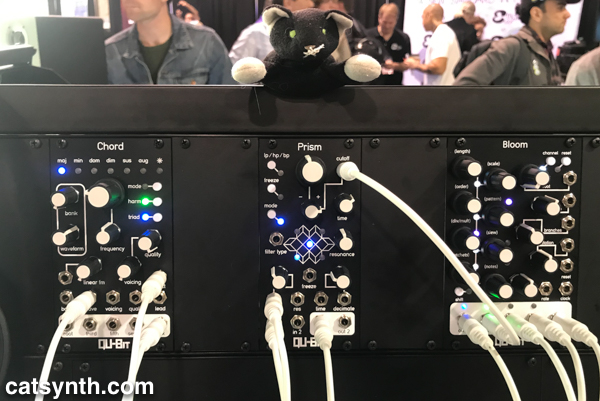
The first of the three was the Prism (center in the picture above). It combines three audio processors that are mapped to a three-dimension “prism” control space. One axis controls a comb filter, another a bit crusher, and the third is time/speed control. The audio processors operate on a buffer, which can either be continuously updated from audio input or “frozen” in time and looped. Finally, there is a
The second module was the Chord, or rather the new incarnation of the chord. It’s a four-voice polyphonic oscillator with both traditional waveforms (continuously morphable) and a new set of wavetables. The oscillators can be stacked into chords, or in this new version each controlled separately for polyphony in the music-theory sense of the word – yes, with the right sequencer, this module can do four-voice counterpoint. The chord mode includes a variety of standard western four-voice chords (i.e., with a seventh degree), but also the ability to add custom chords that include microtones or dense tone clusters. It’s also more compact than the original, slimmed down to just 14hp.
The final module was the Bloom, a sequencer that could generate variations on the fly using a proprietary fractal algorithm. The amount of variation, from none to completely random, can be controlled dynamically via CV, as can the number of steps in the sequence, for quite a range of variety. And with two channels, it would seem to pair nicely the Chord.
As always, it’s fun to visit with Qu-Bit and see what they up to, especially as they are CatSynth superfans. And we look forward to seeing these modules out in the wild over the course of the year. The Prism is due in March, the Chord in late spring, and the Bloom in the fall.
NAMM 2019: Korg Volca Modular and Minilogue XD
We can always count on something new from Korg these days. Sometimes it’s completely new, but this year it was new incarnations of existing lines. We introduced them in a recent CatSynth TV episode and describe them in more detail below.
The Volca series continues to grow with its newest offering, the Volca Modular.
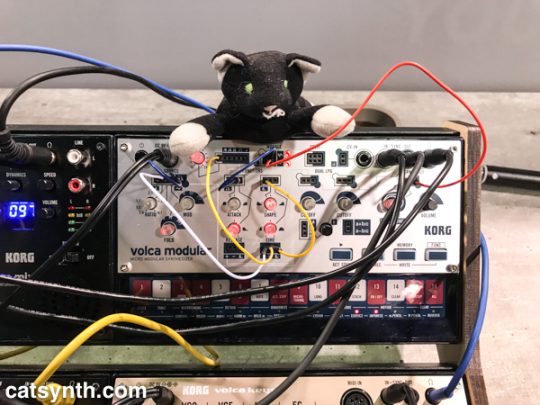
The Volca Modular is a self-contained semi-modular synthesizer in a tiny
It reminds a bit of some other “tiny tabletop semi-modular synthesizers” such as the Moog Werkstatt or the newer Bastl Instruments Softpop (my CDP bandmate Tom Djll uses one of these and thus I want one, too). Like those, the Volca Modular has tiny little patch points and chords, which are adorable. But unlike those, I found it difficult to patch. The wire tips were a bit flimsy and I bent at least one of them trying to create a new patch on the fly. Otherwise, though, I think this is a fine little instrument, and could end up in my Volca collection.
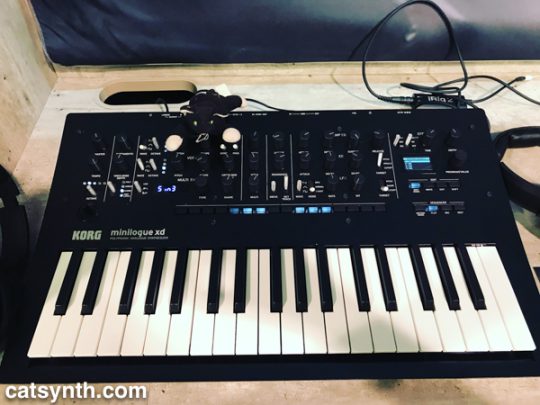
The other new instrument was the revamped Minilogue XD. The original Minilogue made quite a splash a couple of years ago as an affordable polyphonic analog synthesizer. In addition to a nice, darker finish, the XD adds their expandable digital wavetable technology from last year’s Prologue. The digital engine has several different oscillator types and functions, and is essentially a “third sound source” for the instrument. It’s not clear to me whether this includes the same open API that the Prologue has, which would be an unfortunate omission for us at CatSynth, though probably not an issue for most users. It also has microtonal capabilities, something which is missing from many structured MIDI-analog combinations.
Both of these instruments are interesting, incremental changes, with Korg seemingly defending the turf it established in the synthesizer resurgence. Neither is a top priority for us at CatSynth, but I would be surprised if they find their way to us at some point.
NAMM 2019: Behringer Synthesizers
Our 2019 NAMM experience began a little earlier this year when we stopped by Behringer’s offsite event in the Chatsworth neighborhood of Los Angeles. It was an opportunity to check out their current and upcoming synthesizer offerings. You can see some of them in this video.https://www.youtube.com/watch?v=ylvIpER
There is perhaps no synthesizer maker more controversial and more talked about these days than Behringer. Some dismiss them outright, others condemn their cloning of classic instruments, and others applaud their making affordable synthesizers that sound good and play well. Mention them in any synthesizer forum, and you are likely to get more responses than with any other topic.
Overall, I was happy with what I saw from them this year. I particularly liked the Vocoder VC340, a clone of the legendary Roland VP330 vocoder.
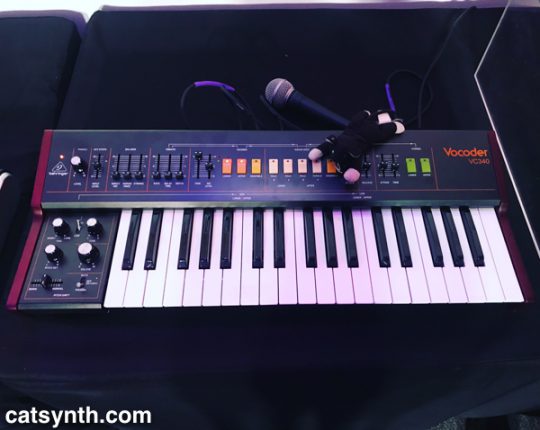
I already own a Roland Boutique VP-03, so I have access to this sound and signal path, with all its temperamental qualities. But the VC340 comes in a larger package with full-size keys, with electronics more similar to the original, including the voice and string synthesizers. It would make a great stage vocoder if I had need and space for one. It is also easier to get external signals into it, and we played around using Behringer’s new Rhythm Designer RD-808 as the modulator signal (you can hear it in the video).
Behringer has also come out with a clone of the Odyssey, simply called Odyssey.
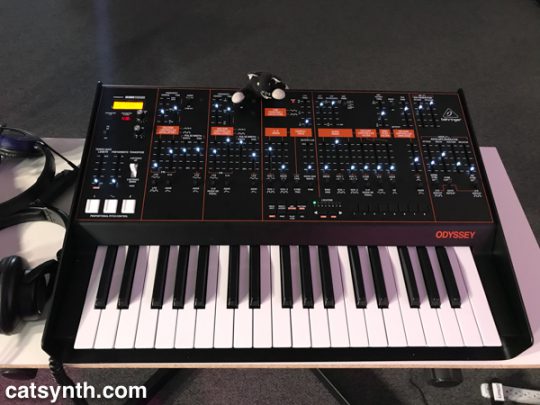
It’s industrial design, font, and colors are remarkably similar to the original (something which probably makes Behringer’s critics howl). But it’s a good sounding unit, and quite rugged looking. The layout of the sliders is a bit different from what I know from the original, the Korg clone, and my Octave CAT, so I didn’t have the opportunity to dial in the “Chameleon” tone and give it the Herbie Hancock test, but I did get some interesting modulated sounds familiar from the original Odyssey.
It is important to note that Behringer has also produced original instruments such as the Neutron.
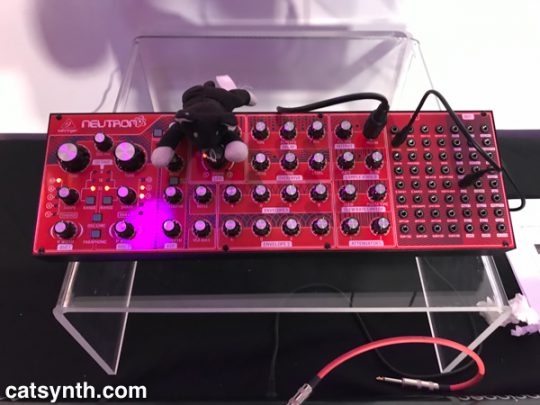
The Neutron is a Eurorack-compatible synthesizer with all the expected VCO, VCF, and VCA sections, as well as an extensive modulation matrix. It does not have a sequencer, but the Eurorack ecosystem is awash with sequencers so that shouldn’t be much of an issue. The Neutron is on the surface similar to the Moog Mother-32 and Arturia Microbrute (sans sequencer), but it does have its own sound. Is it different enough to want it if you already own those instruments? That is subjective. But it played well, and at $399 is quite affordable.
There is also the clone of the Minimoog, the Model D, affectionately known by many of us as “The Boog.”
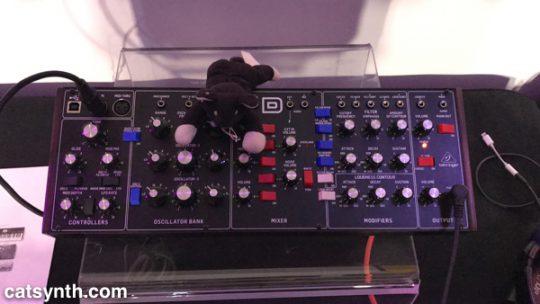
It sounds like a Model D. And it is Eurorack compatible. It’s a great affordable option to get that sound. End of story.
And finally, there is the new MS-101, a clone of the Roland SH-101, complete with red and blue finishes.
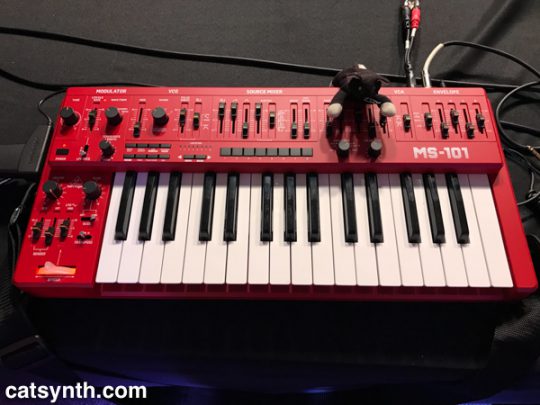
I don’t think the controversies around Behringer will fade anytime soon, especially as they continue to ramp up their synthesizer catalog. For those who complain about their cloning, there are others who charge “elitism” at their critics, considering the high prices vintage instruments and even current Eurorack modules command. Plus, these instruments have MIDI, USB, and other features that are rather handy when making music. We at CatSynth come down somewhere on the outside of this discussion, and simply enjoyed playing the instruments; and we might look into that vocoder.
Interstate 5, California: The Road to (and from) NAMM
At least since 2010, all of my trips to NAMM have been road trips, heading east from San Francisco on I-580 to meet Interstate 5 for the long trek south through Los Angeles to Orange County.

 I-5 takes a more direct route through the sparsely populated western side of the Central Valley, compared to CA 99 (former US 99) that connects the major towns and cities of the region, including Fresno and Bakersfield. The small communities that one does pass are related to travel on the interstate itself or to the farms and orchards that dominate the landscape between stretches of emptier space.
I-5 takes a more direct route through the sparsely populated western side of the Central Valley, compared to CA 99 (former US 99) that connects the major towns and cities of the region, including Fresno and Bakersfield. The small communities that one does pass are related to travel on the interstate itself or to the farms and orchards that dominate the landscape between stretches of emptier space.

It is a long trip, and one that I know many people would find boring. But for me, it is something I look forward to, an integral part of the experience along with the show itself, the after-parties and all the other little adventures. This year there was the added fun of testing out Highway☆ on the road trip, but even without that heightened sense of purpose, it is simply an enjoyable “flow experience.” Once over the Altamont Pass and into the Central Valley, stresses begin to fade as the mostly straight line of the road and the low stimulation of I-5 takes over. It may seem “empty” but there is still is just enough detail along the route to provide balance. After many years, I have come to know just about every major junction and many of the other details, such as the names of the small communities along the highway. By the time I arrive in the Los Angeles basin, I am recharged, enough to even remain unfazed by the notorious traffic!
The return trip along a nearly identical route is similarly an opportunity for psychic calm and flow after the nonstop overstimulation of NAMM (I do spend a half day after the show either with friends or at a museum as part of the decompression process before getting back on “The 5”). This year was no different, as I headed back with a tailwind and sense of optimism. Life seemed calm, free, but also filled with curiosity and excitement about professional opportunities in technology, music, and even travel. That feeling lasted into our arrival back in San Francisco, at least until my second bout of this year’s awful flu kicked in, along with some other stressful local responsibilities. One of the mental exercises to help through the ensuing week was to focus on how my mind and body responded positively to the I-5 trip (and to the many tendrils of travel in and around L.A.) and thought experiments on how to capture that sense of enjoyment and calm even when not traveling down a straight and empty stretch of road. I come back again to flow experience and how much that seems to be a product of solitude for me, but it can also come in playing together with musicians at the highest levels. And then there are situations where flow is stymied or non-existent. It is important to recognize both, and I hope to explore these topics more in upcoming articles.
See more of Interstate 5 in California and many other fine places across North America in our Highway☆ app, available on the Apple App Store and Google Play Store.
NAMM 2018: Blipblox
Among the more unique instruments that we saw at NAMM this year was the Blipblox, a fully functional synthesizer in a plastic shell reminiscent of children’s toys.
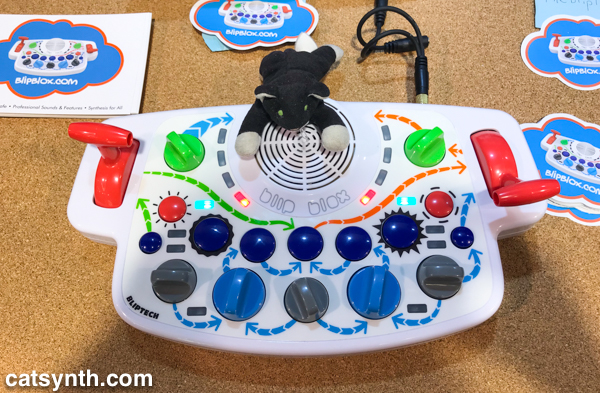
Don’t be deceived by its appearance. The Blipblox is a full-featured monophonic synthesizer with selectable signal topologies and oscillators; a low-pass filter; a sequencer; and even a drum machine. There is also a modulation matrix to complete the feature set. In some ways, it seems similar to overall style and concept of the Moog Mother-32, though it is of course a very different instrument.
You can hear a bit of our attempt to play the Blipblox in this video.
It certainly seems like an interesting way to introduce kids to synthesizers and both the science and art of sound. But it also seems quite usable for live performance – if it’s rugged enough for kids, it’s probably rugged enough for the stage. We look at it an immediately think of the repurposing of musical toys for experimental electronic performance via circuit bending. Whether a Blipblox is bendable or not is beyond the scope of this initial look, but it would certainly fit in with a setup that includes such modified instruments.
More info can be found at https://blipblox.com/
NAMM 2018: Strymon Magneto
At NAMM, one tries out a lot of instruments and walks away wanting to have a good number of them. The novelty fades quickly, but some you find that you continue to really want. The Magneto module from Strymon is in the latter category.

The Magneto is a four-head tape delay simulator. Its controls are very intuitive and playable, with enough flexibility to be used to generate spring-reverb-like sounds as well as function as a looping device via a mode switch. You can see our first attempts with the Magneto in this video.
Strymon put a lot of attention to detail both in terms of sound design and usability into this device. And as one would expect from a Eurorack module, just about every function can receive external CV input, making it more of a musical instrument in its own right than it would be in a studio rack or even a guitar pedalboard. We were able to observe the delay and looping functions in great detail, but it was more challenging to discern the tape-effect functions, such as “wow-flutter” and “crinkle”. Part of that is just the chaotic environment of NAMM (even in the more calm depth of Hall E). Hopefully, we will get a chance to try those out in more detail in the near future.
For more information, please check out https://www.strymon.net/products/magneto/
